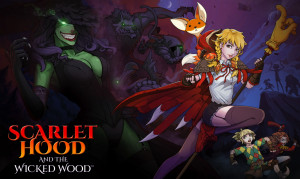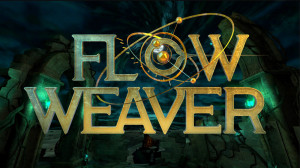Review for Fate of Kai

It’s always intriguing when an adventure game is willing to experiment with unique gameplay mechanics, but using those unique mechanics well tends to be a different story. Fate of Kai is fun as a semi-interactive comic book with nice art and clever time-shifting puzzles, but some frustrating late-game sequences and an incredibly short play time that fails to fully utilize the unique mechanics keep it from being as enjoyable as its format.
We first find Kai waking up in the middle of a field of sunflowers. After getting to his feet and exploring the area for a bit, the young man finds a treasure chest—but when he reaches for it, a shackle lurches out of the trunk and attaches itself to Kai’s wrist. A glowing image on the shackle reveals that the chest must be taken to a castle of some sort, so after trying and failing to break free of the chains, Kai sets off to complete the task and release himself from the burden he’s forced to drag along.
Fate of Kai is presented like a comic book. You click an arrow on the right to flip to the next page, and interaction comes mostly in the form of selecting and moving words in characters’ thought bubbles. For instance, in an early scene you are facing a large mountain. Kai’s thought bubble reads: “climb,” and if you leave it there and move to the next page, you’ll see him climb the mountain, where he’ll encounter an obstacle he can’t overcome soon after. Here Kai’s thought bubble displays: “jump.” You can continue on in the default fashion to see where it leads next, or you can begin to get creative. In this case, you can click to add the “jump” thought bubble to your inventory, turn back the pages to the mountain scene, and switch out “climb” with your new action. Now, rather than climbing the mountain, Kai will jump across stones in the river next to the mountain to reach the other side and continue his journey.
There are also times when you can interact with scenes from the past. In one example, you see a destroyed bridge that you can’t pass. There’s a little hourglass button by the panel of the broken bridge, and clicking it lets you go back in time to see how the bridge got destroyed—turns out, a dragon attack caused the damage. From there you can shift around the words in the characters’ thought bubbles to make it so that the dragon never attacks. When you click the hourglass again and return to the present, the bridge is in perfect condition and you’re able to progress.
The puzzles are mostly easy and clever throughout, until the very last few chapters. One late task has you trying to find your way through some labyrinthine woods. You’re given the option to go left or right at each crossroad, with each decision bringing you to yet another identical fork in the path until you make your way out of the forest. Figuring out the pattern to reach your destination requires you to go back and forth a few times in the pages of the story, and it isn’t nearly as simple as it seems—it isn’t just a matter of figuring out the pattern of the maze, but figuring out the pattern, completing a few events in a specific sequence, and then going through the maze again. I thought I made it a few times, but it turns out there’s a specific sequence of events to actually make it through, so after trying and failing to understand the given clues, I decided to look up a guide to see what the solution was supposed to be. After following it successfully, all I could think was, “Wow, I would have never naturally figured that out.” Trial and error got me close a couple of times, but the way the game gives you the information you’re supposed to use to figure it out only served to make the puzzle more confusing.
An even more tedious sequence in the next chapter—after you’re captured by a large monster who forces you into physical labor—asks you to determine which colored ores to break with a pickaxe, all while a timer ticks away, forcing you to restart if you make a mistake. You have to choose the right colors ten times, and if you choose any of the ten incorrectly, you start all over. This would be frustrating and not very fun on its own, but the fact that some of the colors look extremely similar had me straining my eyes to differentiate between them. I can’t imagine anyone with color blindness being able to complete this sequence, especially since there are no accessibility options. Rather than making me look forward to a big finish, having the two worst sequences one after the other left me hoping the game would end soon by the time I finished the penultimate chapter.
Though some brief bits of writing introduce each of the game’s seven chapters, the story is primarily told without dialogue. Fate of Kai uses a fantasy setting to tell an all-too-relatable story about a man seeking escape from a conformist, soul-sucking job, though I’m not sure the metaphors come across as clearly as they were intended to—the chest Kai is chained to serves as a decent symbol for an emotional “weight” he’s forced to carry around, but other metaphors and analogies feel vague. You would expect an interactive comic book to have multiple endings or some level of player control over events, but that’s not the case. While you do have a choice of how to approach certain obstacles along the way, this is a linear story with puzzles that have one solution tied to one “correct” outcome. It’s disappointing, especially when the narrative isn’t all that unique or fresh.
The bright, cartoony 2D art is nicely done, though I did encounter a specific comic panel or two looking distractingly low-resolution and grainy amongst the other, sharper panels. Otherwise the graphics are colorful and present the tale well in the absence of words, with expressive characters and attractive backgrounds. The cinematic orchestral soundtrack is somewhat less notable than the art, though it’s enjoyable to listen to and adds some much-needed life to the adventure. Gentle kalimba melodies accompany early, calmer scenes, while swelling strings and energetic percussion bring a sense of urgency and tension to more dramatic moments.
All in all, Fate of Kai seems like a solid proof of concept more than a full-fledged game. The central interactive storybook mechanic is interesting but feels undercooked. Finishing in a little less than an hour, I came away remembering the two late periods of tedium and frustration when the game diverged from its clever word-manipulation conceit more than those I enjoyed earlier on. As good as the game looks in emulating the feel of an interactive comic, with such a short play time it really needed to make every panel, puzzle, and chapter count. Instead the experience is too superficial to even invite much replay, despite its promise of player choice, so the end result is one of missed opportunity that I’d love to see corrected in a longer game with a meatier story and puzzles in this same style.



























